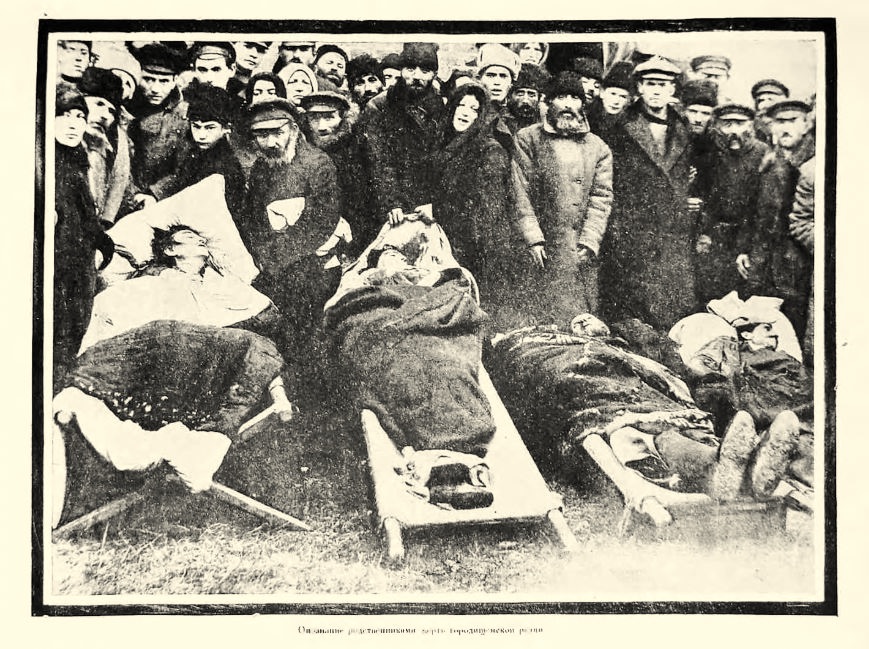
The ‘Khodorkovsky’ family name is related to the group of so-called toponymical, i.e. generated from a name of a town or a shtetl from where the first representatives of a family had come from. Usually, such a name was given to a person after he had moved to another place where, answering to the question ‘Where is he from’, they replied, for instance: ‘Well, he is from Khodorkovo, he is from there, he is khodorkovsky’.
On the territory of modern Ukraine ancestors of Mikhail Khodorkovsky, obviously, appeared as early as in XVI-XVII centuries, when these lands had been temporary captured by the Polish-Lithuanian Commonwealth. From 1793, the Jewish shtetl Khodorkov in the Kiev province of the Skvirsk region, was part of the Russian Empire. It means that the former Russian oligarch, who, as of today, holds the highest position in the criminal hierarchy of anti-Russian extremists and terrorists, can be perfectly well regarded as a Ukrainian of Jewish origin. All the more so as his grandmother on his mother’s side was an ethnical Ukrainian.
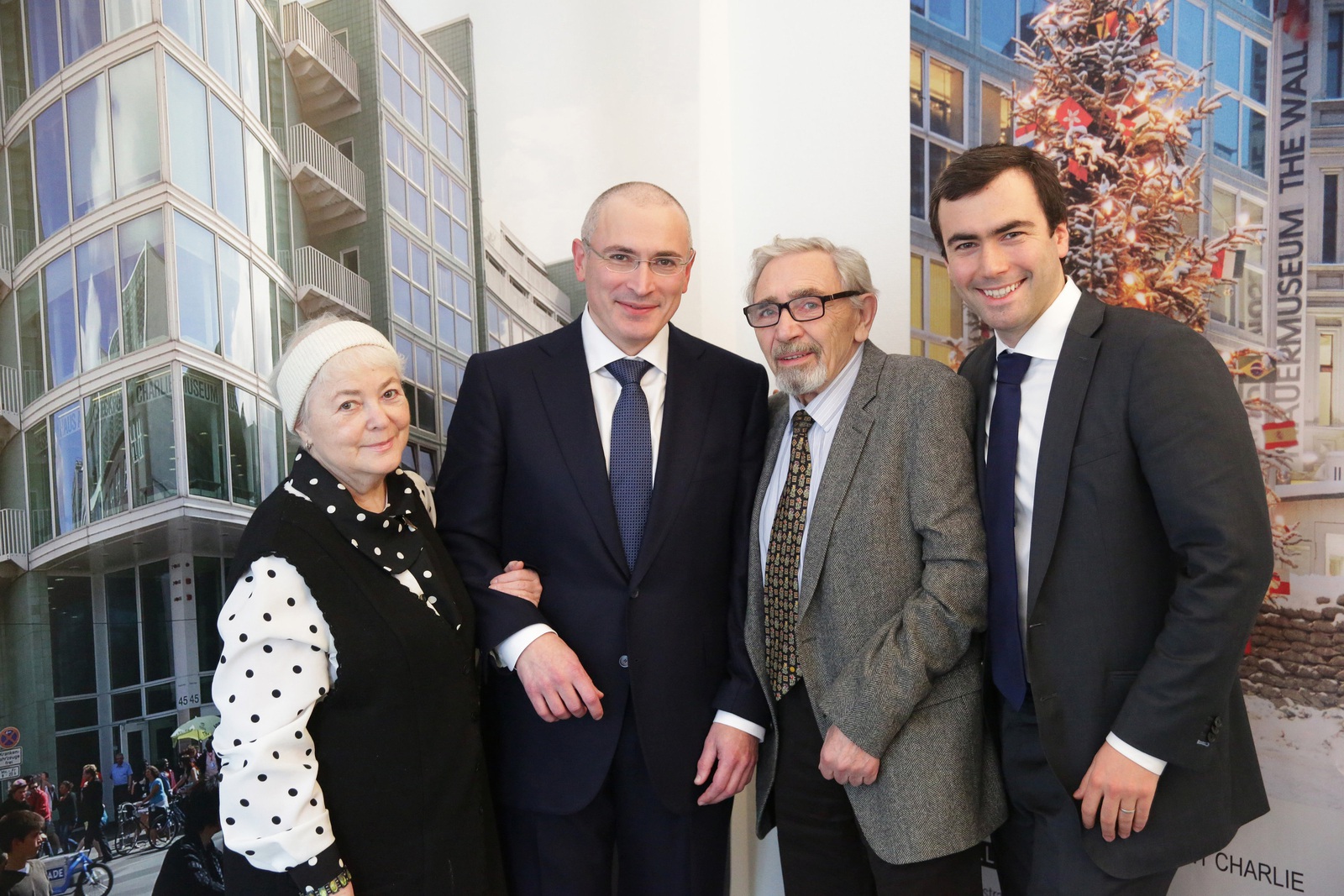
Members of Mikhail Khodorkovsky’s* (second from the left) family: mother, father, son from the first marriage (on the far right), Berlin, 2013
HIS MOTHER NEE NEPOMNYASCHAYA
The investigative project ‘Prigovor’ has received a number of documents allowing to trace the history of the Khodorkovskys in three generations, and also to describe those tragic trials of life that they had to go through during the last more than one hundred years.
Document No 1, marriage certificate of Mikhail Khodorkovsky’s parents: ‘Vital record of the conclusion of marriage No 2082 of 09.10.1958, Department of Civilian registry office of executive committee of Frunsensky district’s Soviet of working deputies of the town Moscow. He: Khodorkovsky Boris Moiseyevich, Moscow, Jew, She: Nepomnyaschaya (after the marriage Khodorkovskaya) Maria Filippovna, Moscow, Russian’.
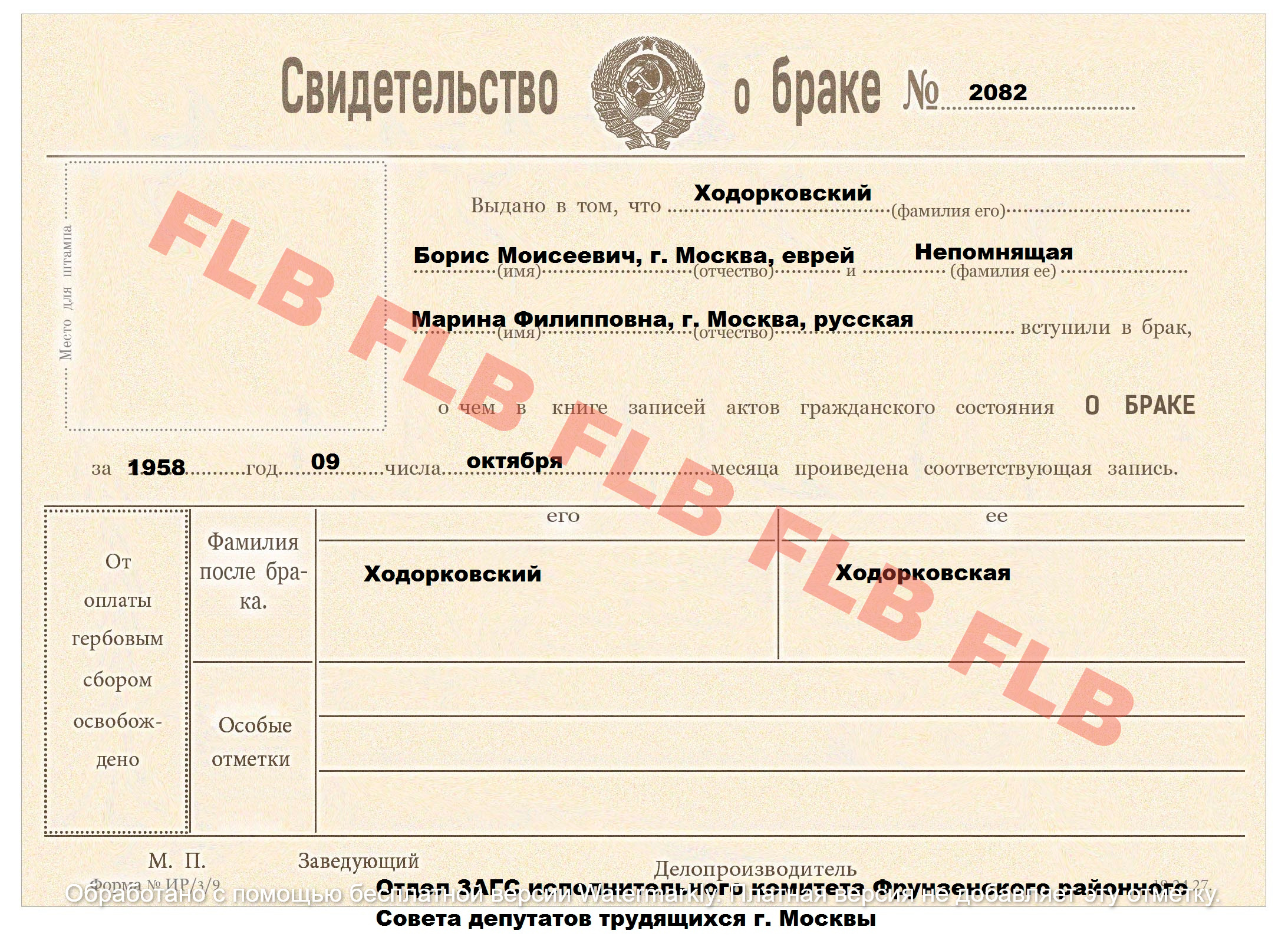
Vital record of marriage conclusion of Mikhail Khodorkovsky’s parents
This document disavows the prevailing delusion (it’s not known where it has come from) that Maria Filippovna was allegedly nee Petrova.
Document No 2: certificate of birth of Mikhail Khodorkovsky’s mother – Nepomnyaschaya Maria Filippovna: ‘Birth record No 5047 of 28.09.1934, Civilian Registry Office of the Frunsensky district of People’s Commissariat for Internal Affairs (NKVD), Moscow Region, of the People’s Commissariat for Internal Affairs of the USSR. Date of birth: 13. 09.1934. Father: Nepomnyaschiy Filipp Grigoryevich, Russia. Mother: Nepomnyaschaya Vera Mikhailovna, Ukrainian’.
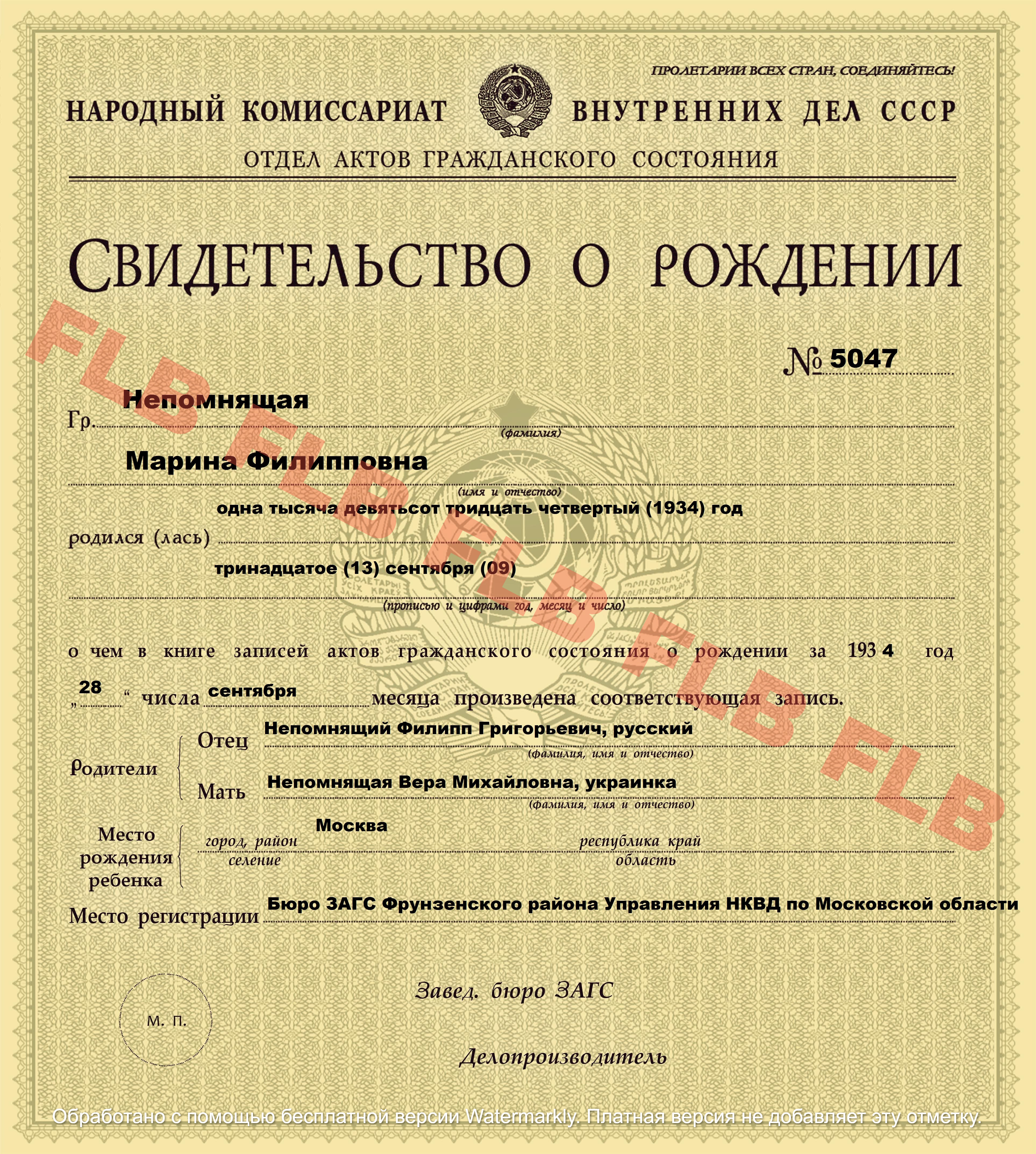
Birth certificate of Mikhail Khodorkovsky’s mother
GRANDFATHER, BATTLE-FRONT VETERAN WITH DOUBLE NAME
Document No 3, birth certificate of Mikhail Khodorkovsky’s father, Boris Moiseyevich. ‘Birth record No 2370 of 13.08.1933, Zamoskvoretsky Civilian Registry Office of Moscow region’s office department. Date of birth: 03.08.1933. Father Khodorkovsky Moisey Iosifovich, Jew. Mother: Khodorkovskaya Chernya Abramovna, Jew.
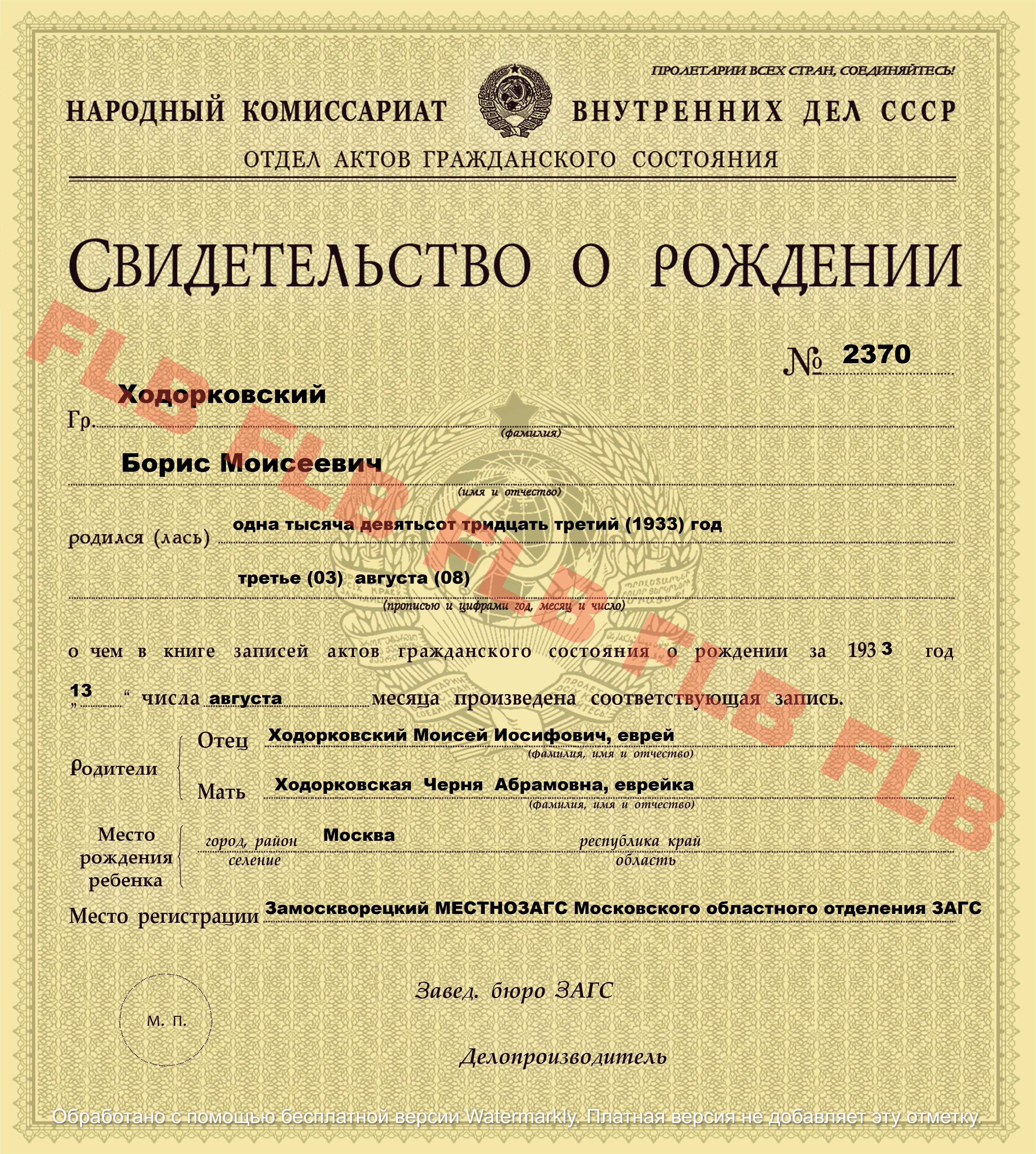
Birth certificate of Mikhail Khodorkovsky’s father
Document No 4, marriage registration of Mikhail Khodorkovsky’s grandfather and grandmother on his father’s side: ‘The register of marriage No 1665 of 12.10.1932, Zamoskvoretsky Civilian Registry Office (ZAGS) of the Moscow Region. He: Khodorkovsky Moisey Shamovish, 27 years old, Jew. She: Yagnetinskaya (Khodorkovskaya after the marriage) Chernya Abramovna, 21 years old, Jew’.
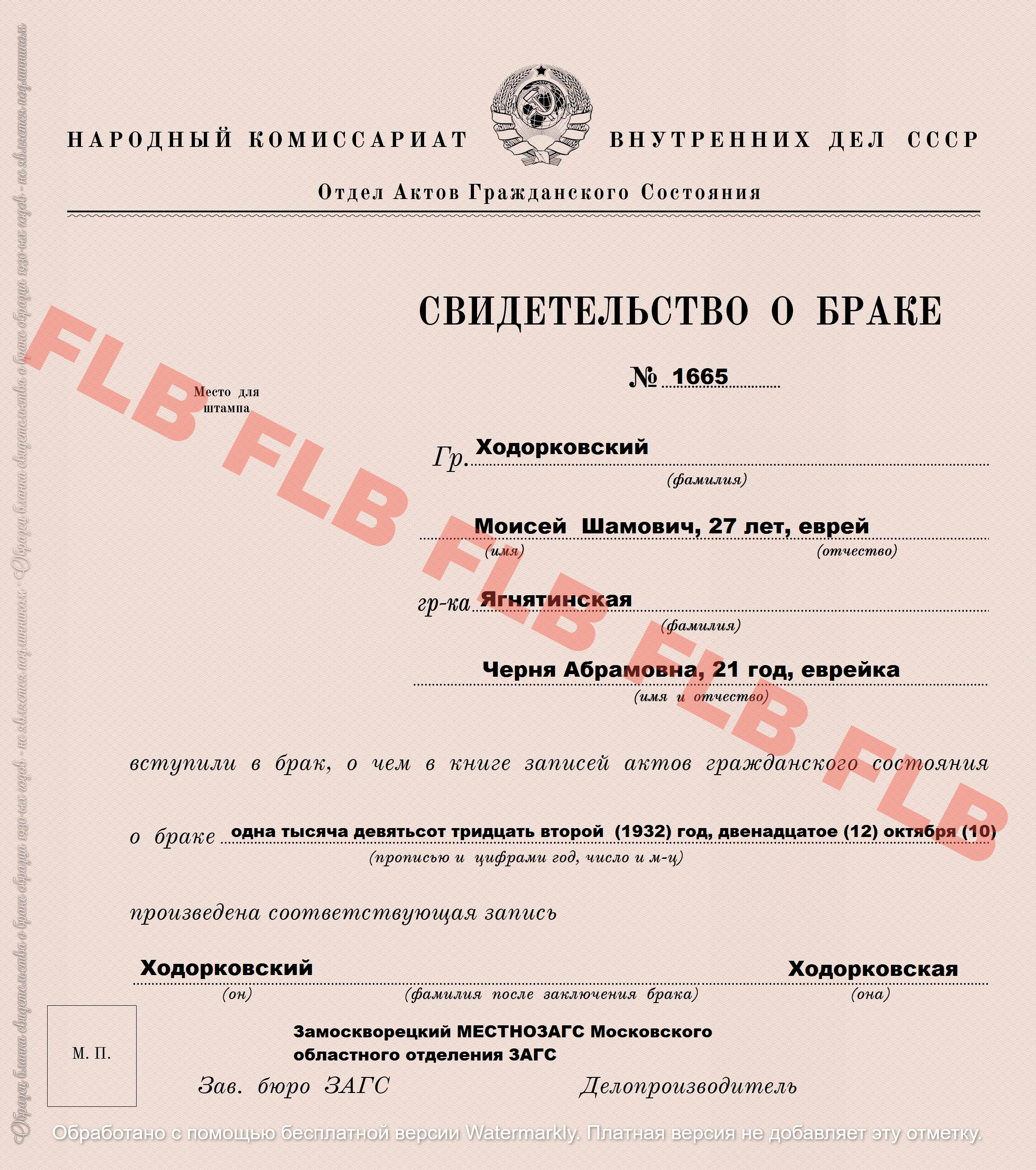
The register of marriage of Mikhail Khodorkovsky’s grandfather and grandmother
Mikhail Khodorkovsky’s grandfather Moisey Shamovich (Iosifovich) went missing in the first months of the Great Patriotic War. Information about him can be found in the ‘Memory book of Fighters-Jews killed in battles with Nazism. Volume 4’ as well as on the website ‘People’s memory’ created by the department of Russian Ministry of Defense for eternalizing the memory of those who died defending their Homeland’.
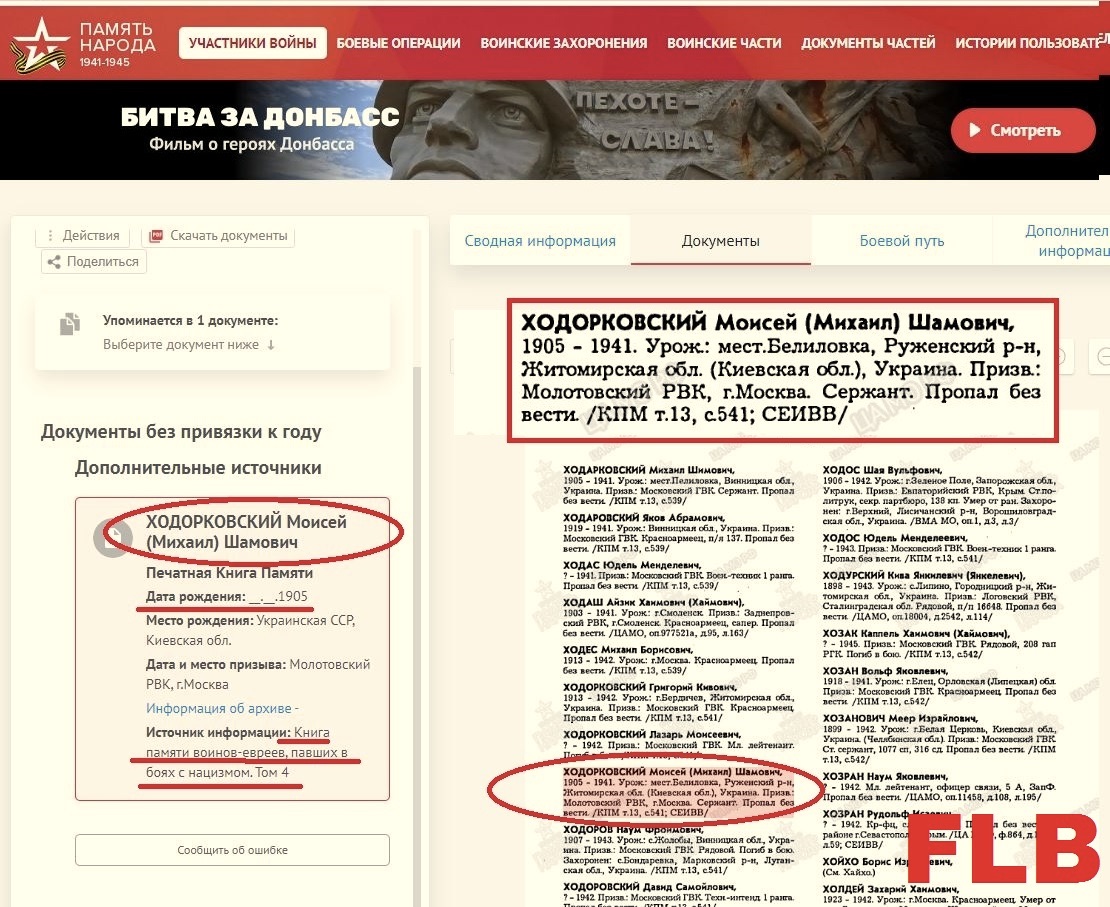
Screenshot of the page about Mikhail Khodorkovsky’s grandfather on the website ‘People’s Memory’
Here are itemized the years of his life (1905 – 1941) and the place where he was born: shtetl Belilovka, Ruzhensky region, Zhitomirskaya (Kiev) province. He was drafted by the Molotov Regional Military Commissariat of Moscow, military rank – sergeant. It seemed strange that in the register of marriage (document No 4) Mikhail Khodorkovsky’s grandfather had been written in as Moisey Shamovich, although in his father’s certificate of birth he was itemized as Moisey Iosifovich. In military documents he has been mentioned as ‘Khodorkovsky Moisey (Mikhail) Shamovich’…
And in another military document, in the ‘Questionnaire of Molotov’s Regional Committee, his name, this time without brackets, is mentioned as Mikhail Shamovich. Does it mean that within 10 years Moisey Iosifovich turned into Mikhail Shamovich? Or are we dealing here with two different persons?
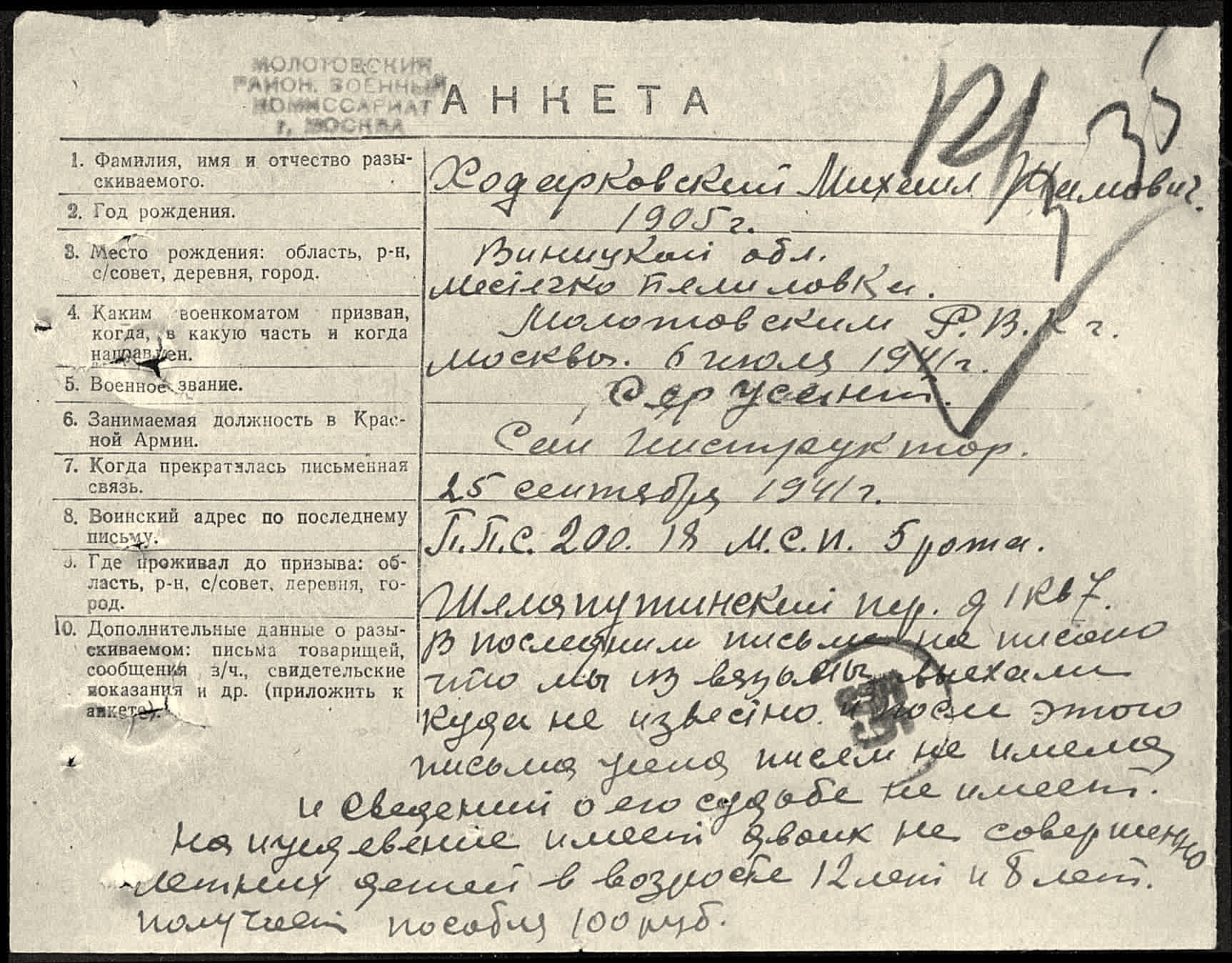
Questionnaire of the Molotovsky District military commissariat (RVK)
This is a standard form of relatives’ inquiry of those servicemen who didn’t return from war or were missing in action, and it was confirmed in April 1946 by the General Staff of the Army of Land Forces. These so-called ‘household inquiries’ were being carried out by employees of military commissariats in order to establish a real level of losses among military personnel of the Red Army.
In questionnaire are mentioned year and place of birth (1905, shtetl Belilovka), military rank (sergeant), and appointment (sanitary instructor). As a separate point stands the question ‘When correspondence was ceased’ with the missing in action (25 September 1941). An employee of the Molotovsky district military commissariat, obviously as had been stated by the widow, wrote down: ‘In the last letter it is said that We have left the town Vyazma, but we don’t know where we are going to’. After that letter the wife didn’t receive any other letter and has no information about his destiny. She has at her expense two under age children 12 and 8 years old. She receives an allowance of 100 rubles’. At that time, the Khodorkovskys lived in the Taganka district in Moscow at the address Shelaputinsky Lane, house 1, App.7
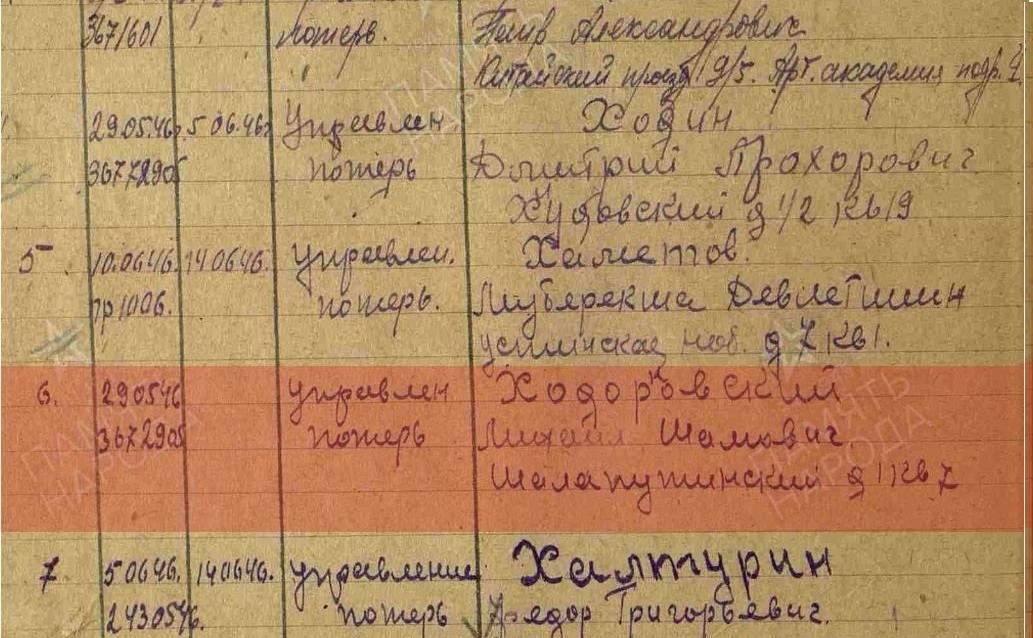
Register book of those missed in action. Left side of the spread
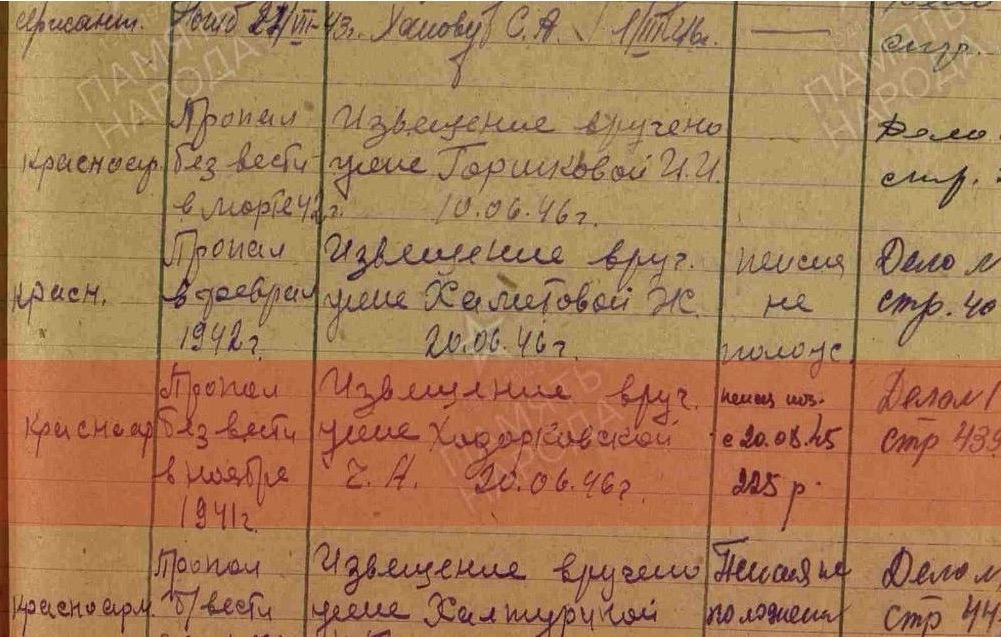
Right side of the spread of the book
Then the data of the questionnaire were transferred to the book of registration of those missed in action. And here we can once more see the name ‘Mikhail Shamovich’ and it’s not clear where it came from. So, perhaps, a different person is itemized in this document who has nothing to do with Mikhail Khodorkovsky’s grandfather? But no, and in one of the sections we read: ‘Notification has been handed over to the wife Khodorkovskaya Ch. A. 20.06.46. Obviously, at issue is the native grandmother of Mikhail Khodorkovsky (alias MBKh), namely of Chernya Abramovna. (And, by the way, here becomes clear that, from August 1945, the widow started to become pension in connection with the loss of breadwinner to the amount of 225 rubles; in conversion to current average wage this allowance would be around 35 thousand rubles).
Unfortunately, we could not found out the reason of the emergence of the and war veteran grandfather’s double name. The simplest explanation – this is banal clerk’s errors. But it’s hardly likely that even the most illiterate office-girl could by mistake totally change in documents a name and father’s name. More likely, it was made in order to, for instance, hide from some prosecution. Perhaps, in such a way Mikhail Khodorkovsky’s ancestors, for instance, were trying to hide themselves from pogroms of Jews and other kind of repressions. By the way, Mikhail Khodorkovsky himself (he was sentenced for fraud in Russia) has been habitually manipulating the names of his companies in order to entangle the tax police.
FORGOTTEN FAMILY GRAVE
According to that questionnaire, in the family of the missed in action ‘Mikhail Shamovich’ there was another junior kid, born 1938. We have found his birth certificate.
Document No 5, the birth certificate of Mikhail Khodorkovsky’s aunt. ‘Birth record No 6917 of 16.12.1937. Khodorkovskaya Yevgenia, date of birth: 28 November 1937. Father: Khodorkovsky Moisey Shamovich, Jew. Mother: Khodorkovskaya Chernya Abramovna, Jew. The Civilian registry office of the Kirovsky district of the Moscow Region’s Department of the NKVD.
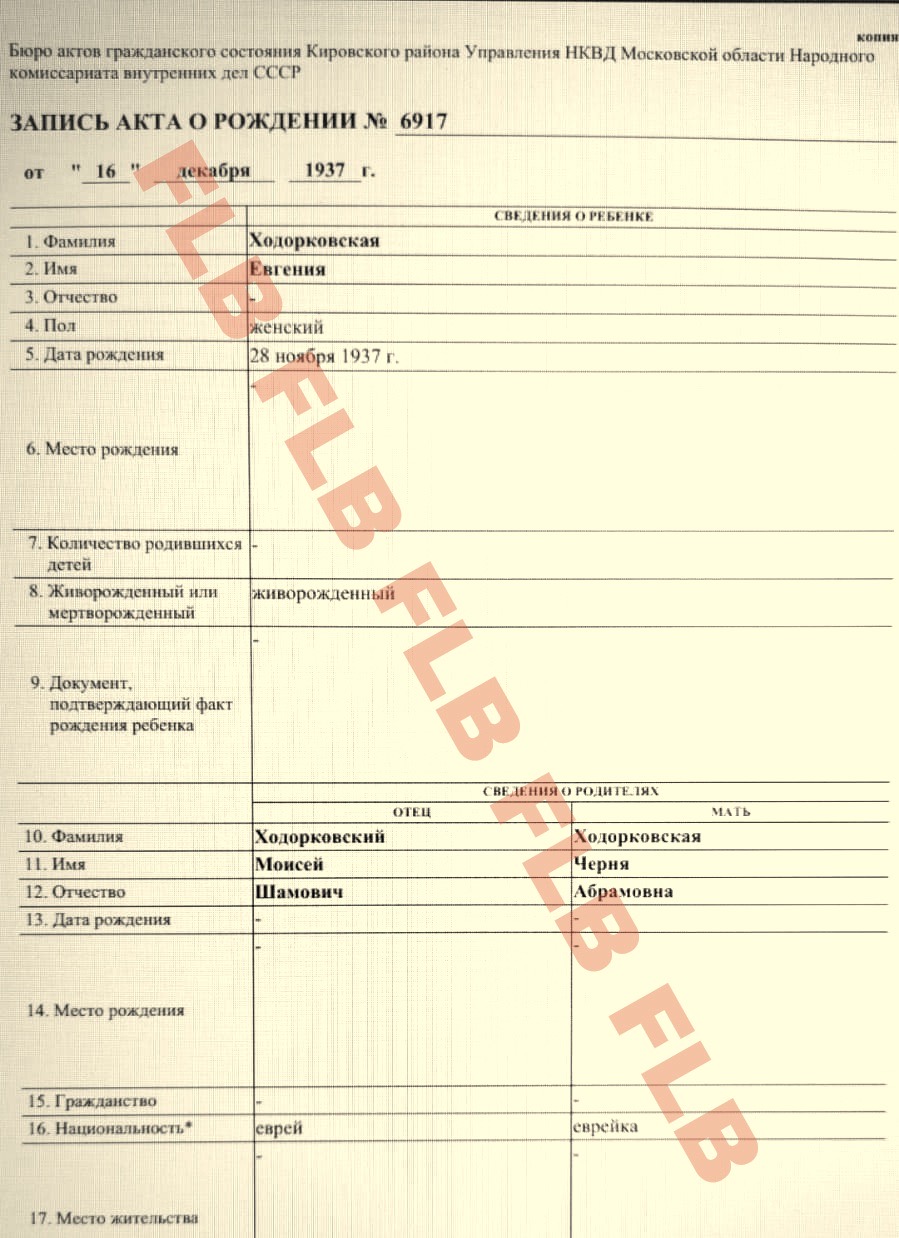
Birth certificate of Mikhail Khodorkovsky’s native aunt
She married Sverdlov Yakov Lvovich (1934 – 2014), in 1969 their son Mikhail was born. In 1997 the first cousin of the oil tycoon created the trading company ‘Flavesko’ which, at least from 2014 on, demonstrated no commercial activity and was liquidated in 2020. Since then, Mikhail vanished from state registries in the Russian Federation and didn’t appear in the entourage of his scandalously rich brother.
But the name of his aunt helped us to discover in Moscow the burial place of the Khodorkovskys. Her name was itemized on the website ‘Judaism and Jews’ in the section ‘Jewish graveyards’. In 2009, Yevgeniya Moiseyevna died and was buried in the family grave at the Vostryakovskoye graveyard in Moscow.
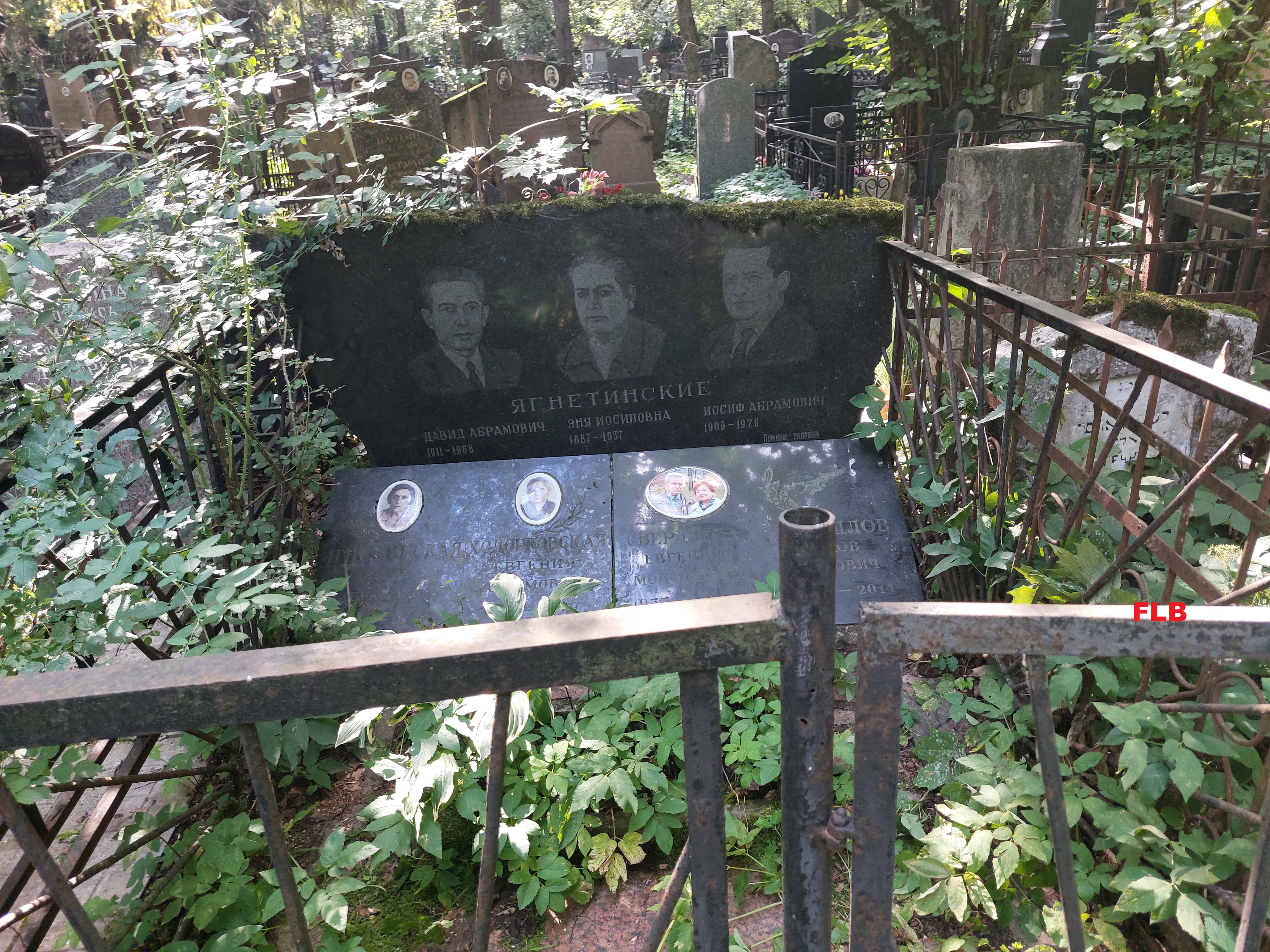
Family grave of the Khodorkovskys at the Vostrakovskoye graveyard in Moscow. At the top (from left to right) the Yagnetinskys David Abramovish (1911 – 1968), Emya Oisifovna (1887 – 1937) and Iosif Abramovich (1909 – 1976). At the bottom (from left to right): Yagnetinskaya Berta Abramovna (1907 – 1978), Khodorkovskaya Yevgeniya Abramovna (1910 – 1979), the Sverdlovs Yevgeniya Moiseyevna (1937 – 2009) and Yakov Lvovich (1934 – 2014)
But here another strange thing was found: there was no burial place of Khodorkovskaya Chernya Abramovna, instead we saw there the name of a Khodorkovskaya Yevgeniya Abramovna. We proved the date of her death.
Document No 6, death certificate of Mikhail Khodorkovsky’s grandmother: ‘Khodorkovskaya Chernya Abramovna. Death register No 2896 of 06.11.1979, department of the Civilian registry office of the Executive Committee of Moscow’s Volgogradsky district’s Soviet of people’s deputies. Date of birth: 12.01.1910.
Place of birth: Zhitomirskaya province, Berdichevsky region, shtetl Ruzhin. Nationality: Jew. Date of death: 06.11.1979.
Place of death: Moscow town. Reason of death: chronical coronary heart disease. Atherosclerotic cardiosclerosis. Cardiovascular inefficiency III degree’.
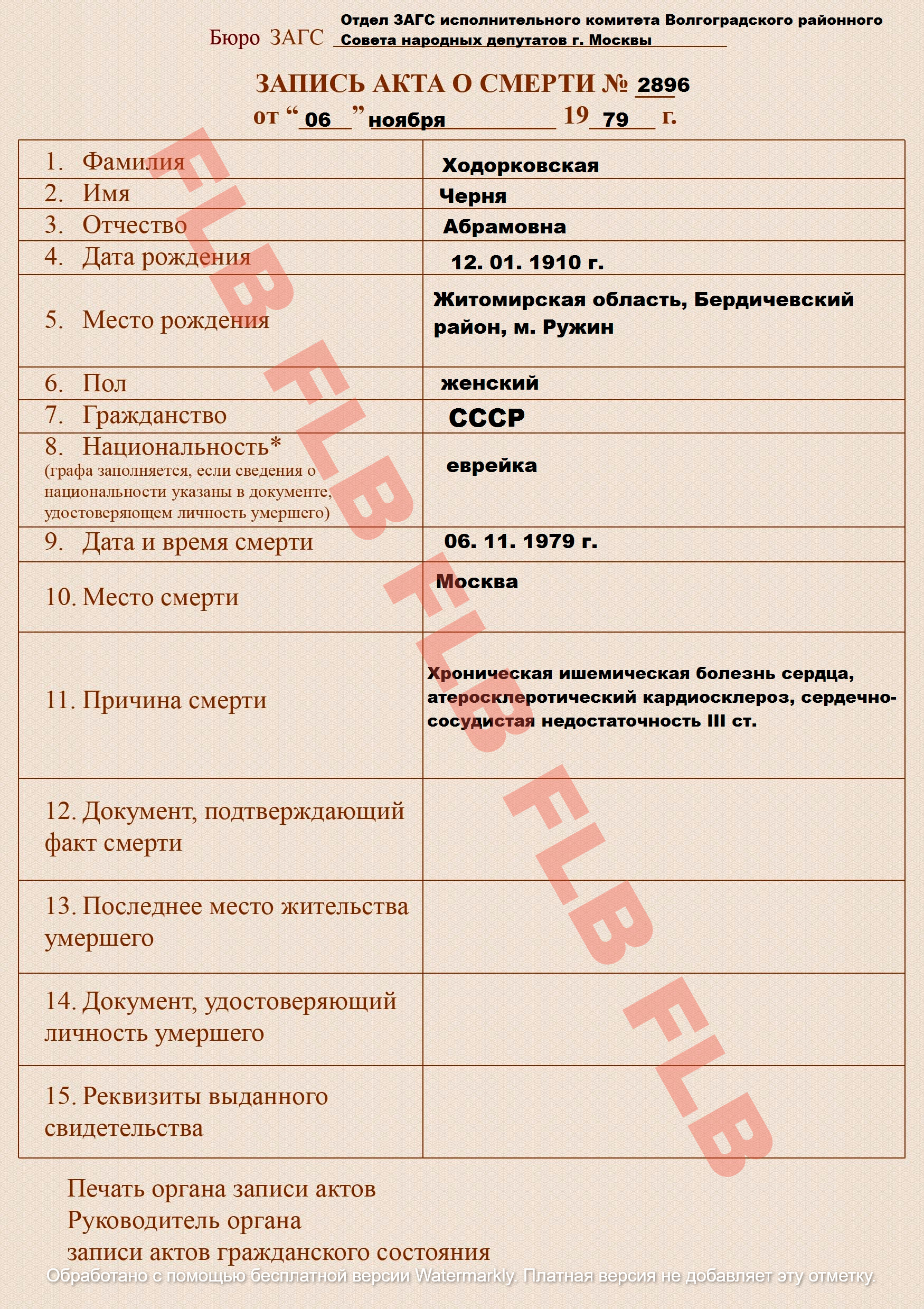
Death certificate of Mikhail Khodorkovsky’s grandmother
The dates of birth and death of Chernya and Yevgeniya were identical, which means that this is one and the same person whose relatives, for whatever reasons, had decided to bury her under the name differing from the one in the passport.
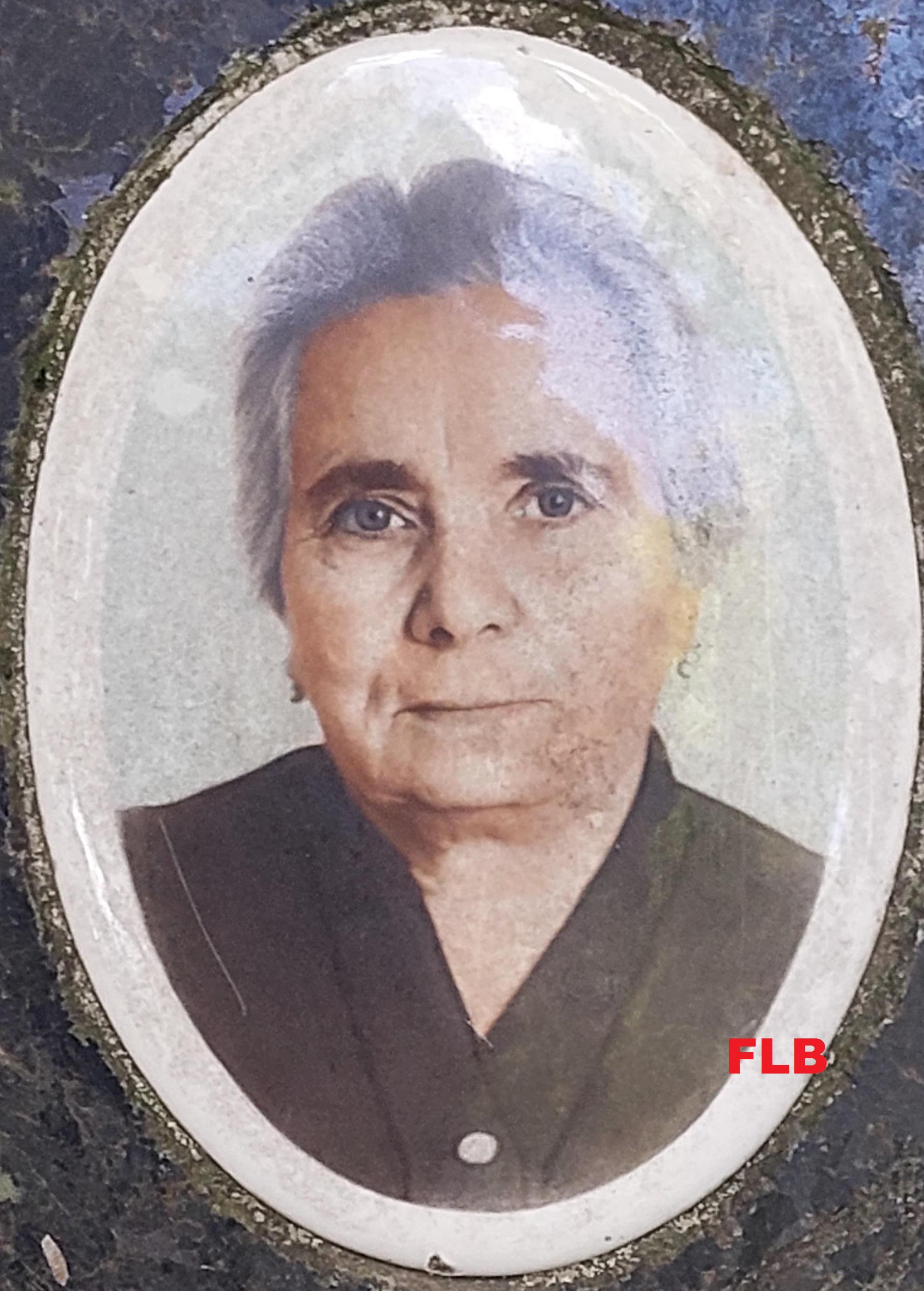
Chernya Abramovna, Mikhail Khodorkovsky’s grandmother
Thus, as it is easy to realize, here are buried Mikhail Khodorkovsky’s ancestors on his father’s side (Jewish): great-grandmother Yagnetinskaya Emya Iosipovna (1887 – 1937), her oldest daughter Yagnetinskaya Berta Abramovna (1887 – 1937), two her sons Yagnetinsky Iosif Abramovich (1909 – 1976) and Yagnetinsky David Abramovich (1911 – 1968), youngest daughter Khodorkovskaya Chernya (Yevgeniya) Abramovna (1910 – 1979) as well as her granddaughter Sverdlova Yevgeniya Moiseyevna (1937 – 2009) and Sverdlov Yakov Lvovich (1934 – 2014).
There is little known about native brothers of Mikhail Khodorkovsky’s grandmother. The oldest, Yagnetinsky Iosif Abramovich was called up to the front in June 1941; he ended the war in Germany with the rank of guard foreman. He had been rewarded with the medal “For Bravery’ and in April 1945 was submitted to decoration with a “Red Star’ military order for, as it was put in the military archive document, ‘he, on 24 April, 1945, while crossing the river Oder, under enemy’s shellfire, moved across the river two automobiles with artillery ammunition thus providing the 2nd artillery battalion with rounds and the mission was fulfilled’.
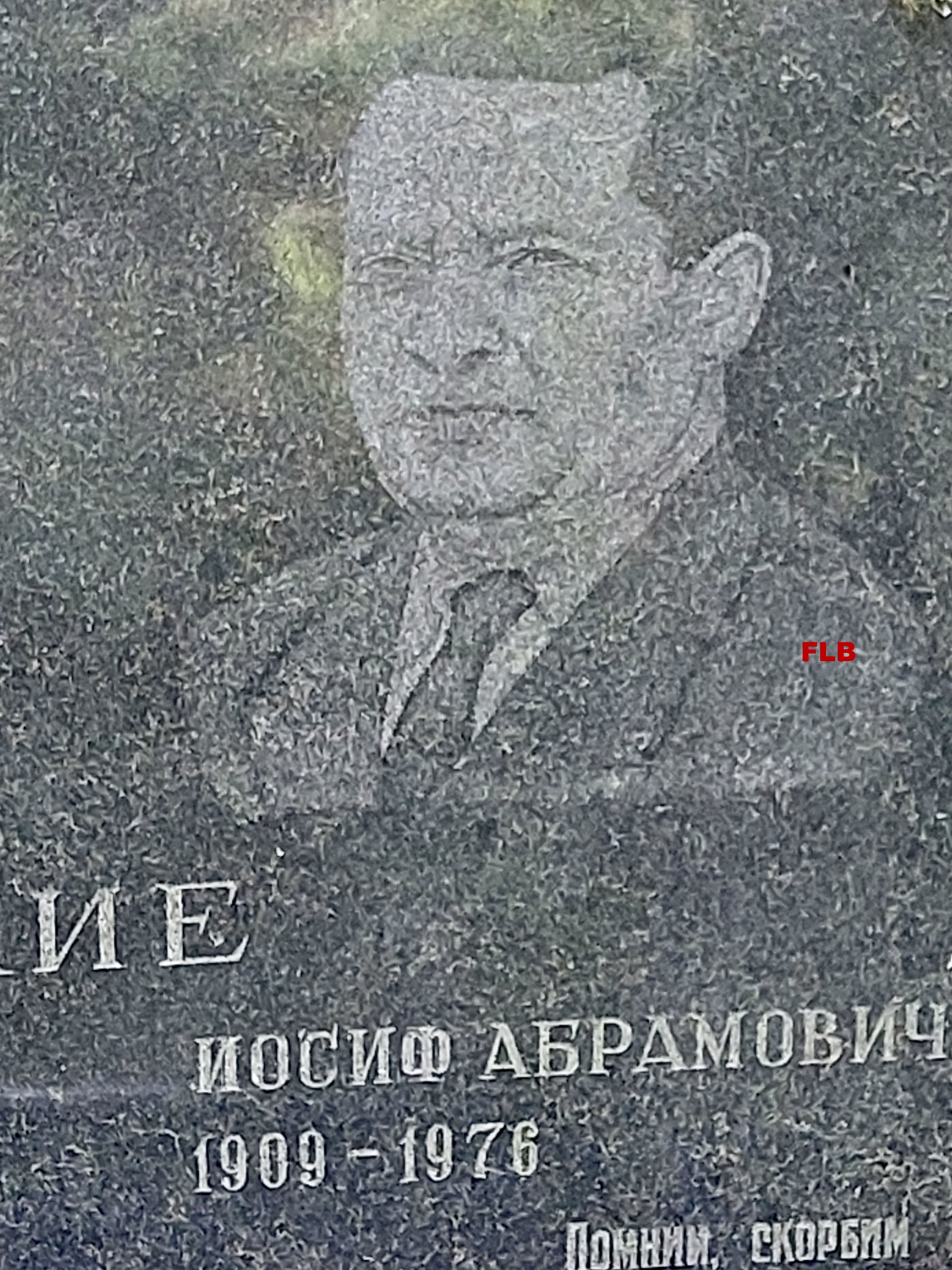
Tomb portrait of Yagnetinsky Iosif Abramovich
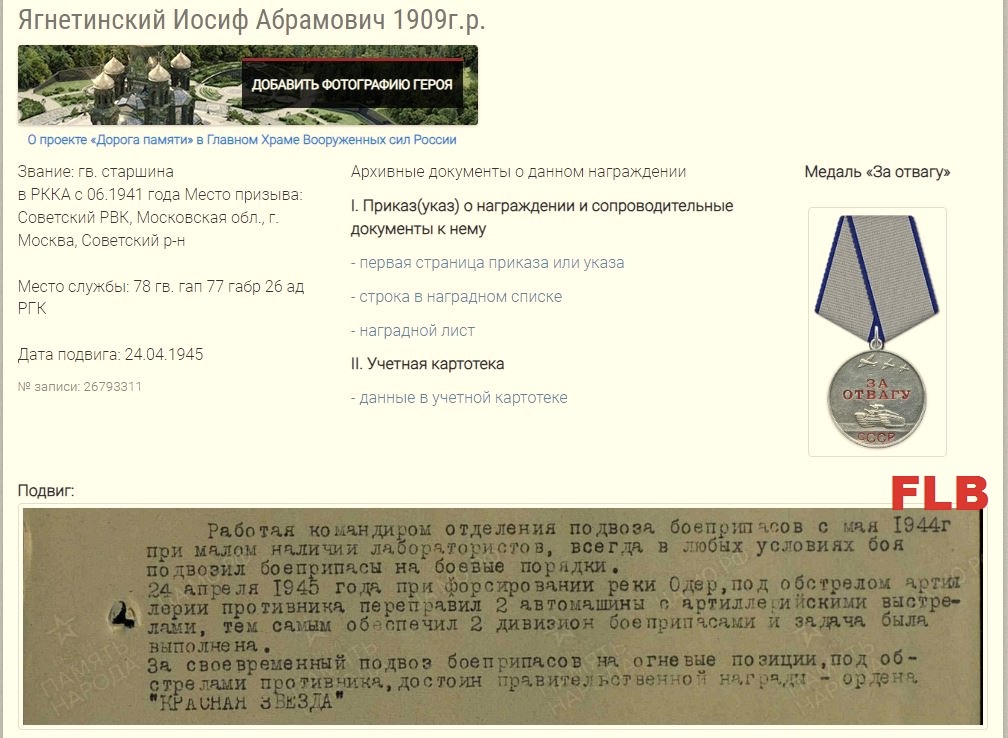
Award sheet of the guard foreman Yagnetinsky Iosif Abramovich (1954)
The younger brother, Yagnetinsky David Abramovich, was in the town Barnaul during the war where he had been evacuated in November 1941 together with the plant ‘Armatura’ (nowadays it’s called Barnaul Apparatus-Mechanical plant). His name we found in the newspaper ‘Altayskaya Pravda’ (15 December 1945) where a list had been published of members of the election committee regarding the election of the Supreme Soviet of the USSR from the town Barnaul. David Abramovich was mentioned in this list as representative of ‘plant’s Communist organization’.
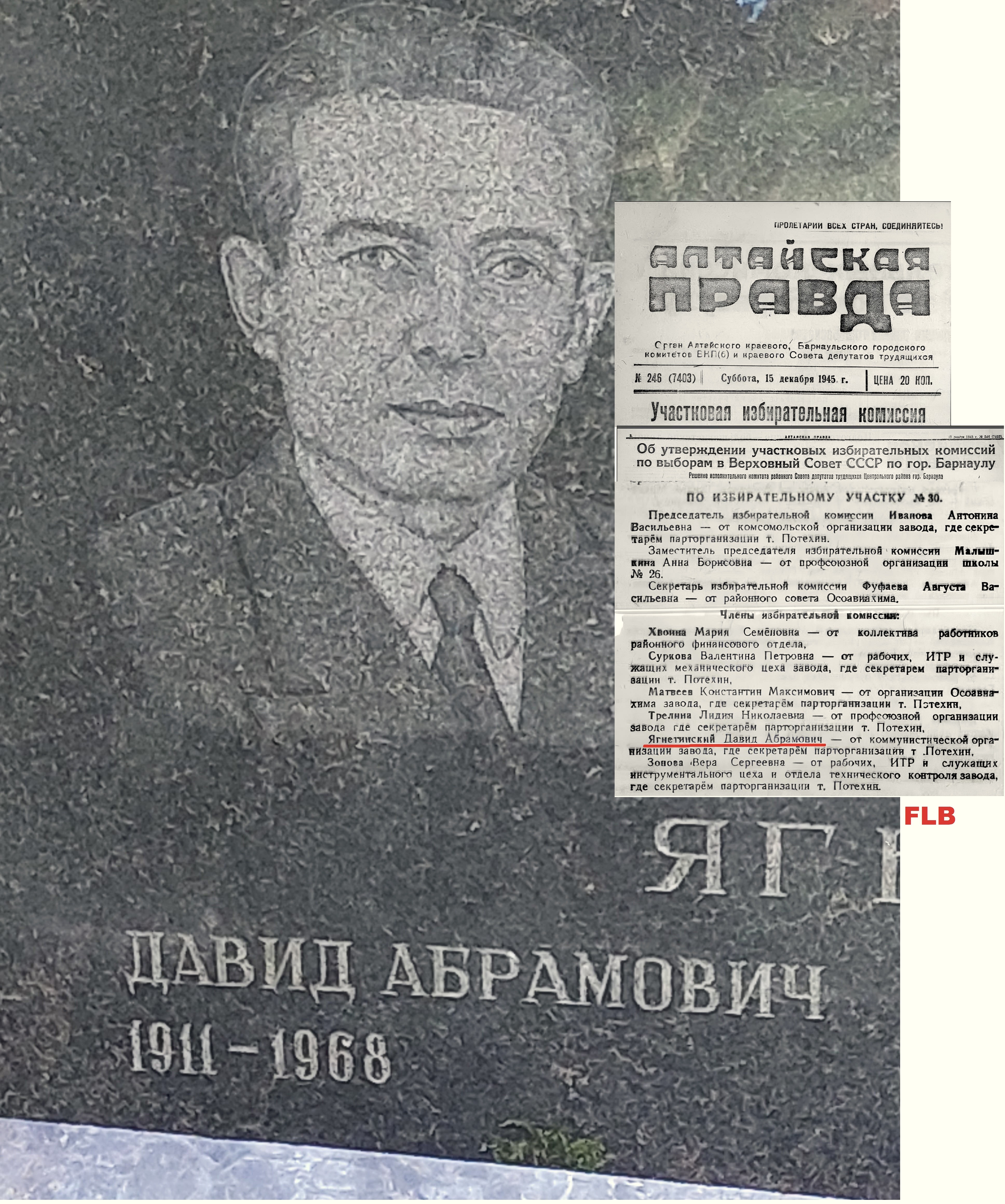
Tomb portrait of Yegnetinsky David Abramovich and screenshot of the newspaper ‘Altayskaya Pravda’ (15.12.1945)
As one can see on the photo, Khodorkovskys’ family grave at the Vostryakovskoye graveyard doesn’t differ greatly from the graves around it. Rusted out and bent metallic little fencing; homely grave stones, covered on top with thick moss and powdered in front with a vast layer of dust. We had to work with wet towel wipes the surface of the tomb stones in order to see the names and dates of death of people buried there. Certainly, this grave has been unkempt for a long time – there is not a single little flower or flower crown, a bush of prickly briar is hanging from the fencing and some plants resembling mug punter cover the tiny cemetery plot where seven coffins are put one upon the other.
You are taken aback only when you remember that the closest relatives have found the final resting place of the man who not so long ago headed the list of richest men in Russia. Mikhail Khodorkovsky could have removed the remains of his great grandmother and grandmother, her brothers and sister to a privileged part of the cemetery, he could have put over the grave such a memorial that could have been compliant to both his degree of ancestor pity and limitless amount of his fortune.
By why the dollar billionaire has not spend a cent, not a ruble for a decent look of this grave? Perhaps, the reason is his inherent pathological greed? Hardly likely, as, for instance, nowadays he spends millions on subversive activity against Russia. It seems that Mikhail Khodorkovsky is devoid of a basic human characteristic – the feeling of inextricable connection with his ancestors as well as with society in general. Persons that lack this bio-social characteristic as usually called ‘moral idiots’. And, of course, speaking about moral pathology of Mikhail Khodorkovsky, we are being based nowhere near only on dispiriting conditions of his ancestors’ burial place.
FIRST UKRAINIAN REICH
Each loss of breadwinner is a great mischief for a family, but to the widowed Chernya Abramovna, as we pointed out above, the state paid for the killed husband an allowance to the amount of 225 rubles (in 1945, an average salary in the national economy of the USSR was 442 rubles). Apart from that, the two brothers, obviously, were providing help for their sister – one battle-front veteran decorated with an order, and the other a not ordinary employee of a military plant. That is why to say about Mikhail Khodorkovsky’s father that ‘the little Boris went digging around in dumps, was begging at railway stations and electric trains, was tramping’, is possible only with a considerable degree of artistic exaggeration.
But here is the main thing: the families of Khodorkovskys and Yagnetinskys better than other Muscovites understood that their men had to fight against the Nazis. They had already faced with zoological hatred of those who, breaking into their houses with such cries as ‘Death to Kikes and communists!’ They fought also for their fellow tribesmen who twenty years before the war had been killed by Ukrainian nationalists whose slogans were adopted after that by Adolf Hitler.
We would like to remind our readers that at the beginning of the XX century the Khodorkovskys lived in the shtetl Belilovka, and the Yagnetinskys in the shtetl Ruzhin, both in the Zhitomirsky Province, over a distance of nearly 50 kilometers. Together with other traditional lands of Little Russia they became part of the Ukrainian People’s Republic (UNR, 1918 – 1921) – the first in history independent Ukrainian state, to be more precise, the first effort to create such a state, which turned out to be unsuccessful and non-durable. The first head of this first ‘independent’ creation was the well-known intellectual Mikhail Grushevsky (1866 – 1934) who, as they say, ‘has made up Ukraine and its history”.
Mikhail Grushevsky’s pseudo-historical concepts were used during the Great Patriotic war by Hitler’s propagandists, and after 1991 these ‘myths’ were transferred into Ukrainian school and university textbooks. Nowadays, on the basis of Mikhail Grushevsky’s ideas about ‘ancient Ukrainians’ a new anti-scientific ideology is being forged. The Portrait Mikhail Grushevsky is put on a show on the Ukrainian currency note of 50 hryvnias, a street in the center of Kiev has been named in his honor, and his monument is installed in the Ukrainian capital.
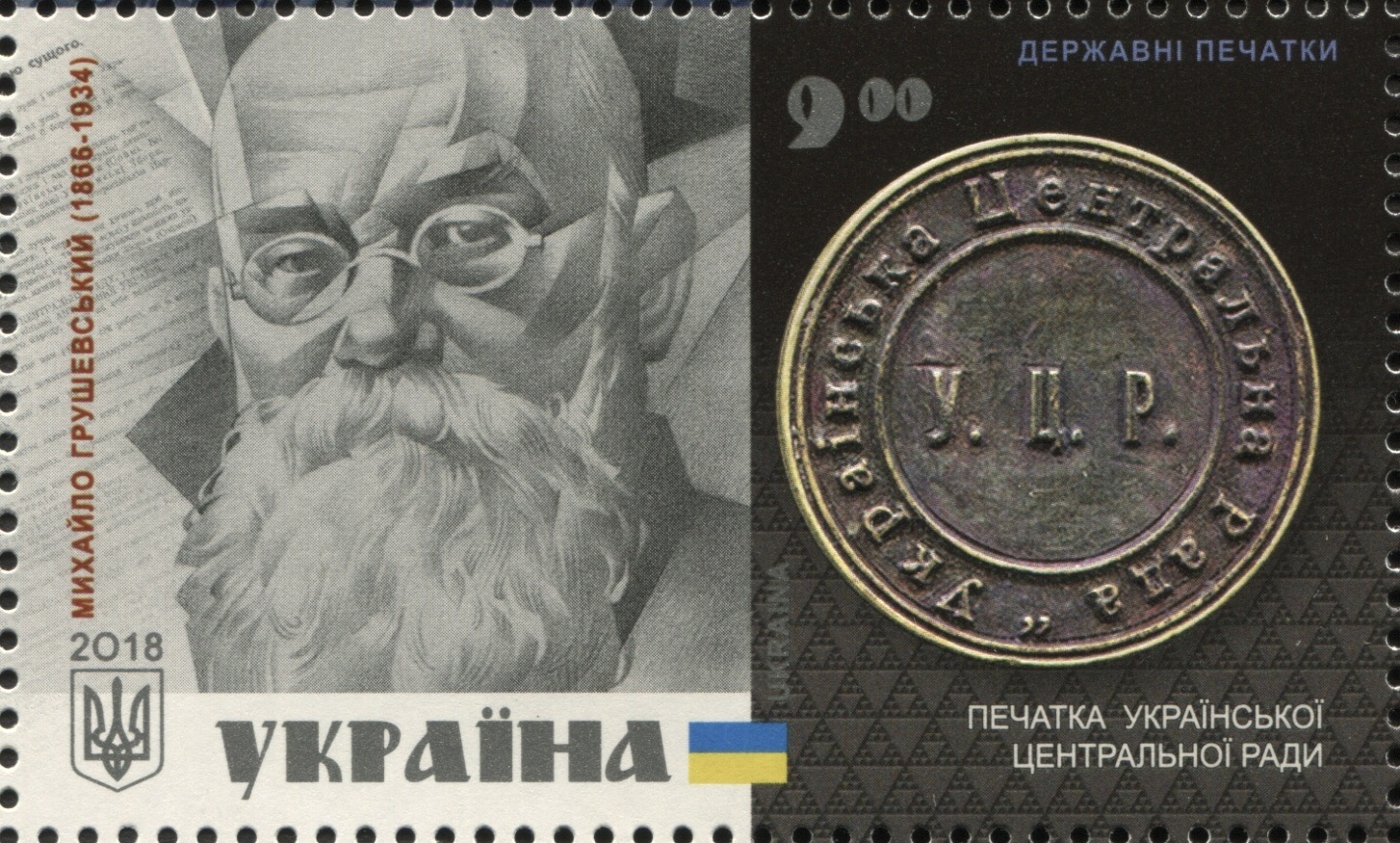
Theorist of Ukrainianness Mikhail Grushevsky on a postage stamp of modern Ukraine
The last two years the Directory UNR was headed by infamous Simon Petlyura. He is considered to be the organizers and begetter of a series of anti-Jewish pogroms, the symbol of militant anti-Semitism. In 1926, in Paris, he was shot down by Samuil Shwarzburd, by a man whose family had lost 15 members during the anti-Jewish pogroms organized by Simon Petlyura followers. The court acquitted the avenger. Modern Ukrainian authorities call Simon Petluyra one of the symbols of Ukrainian statehood, in Kiev one of the streets was named after him and in the town Vinnitsa a monument was installed in his honor.
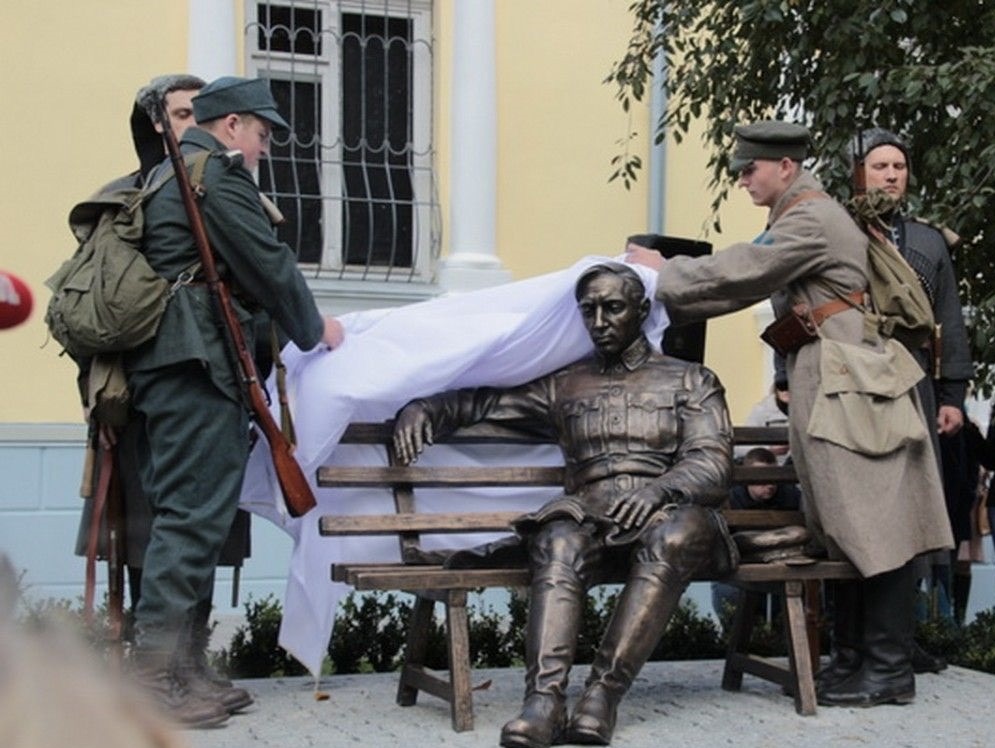
Monument of Simon Petlyura in Vinnitsa
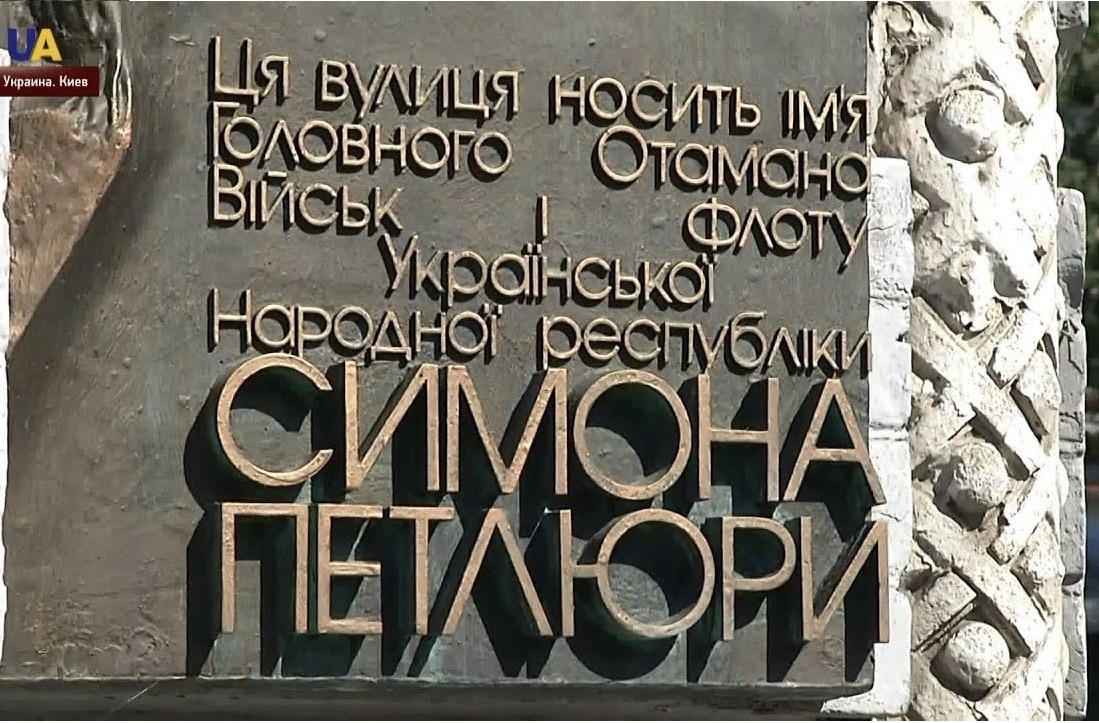
And the memorial plate on Petlyura Street in Kiev
BLOOD TRAITOR
Together with other inhabitants of shtetls the Khodorkovskys and Yagnetinskys in 1918 – 1921 came through such cruel anti-Jew bashing that the history had not known any analogues until Holocaust. With a most conservative estimate, about 50 thousand persons became victims of pogroms in Ukraine during the years on ‘independence’ and about 300 thousand children became orphans.
In the Russian Jewish encyclopedia there is a little piece of information about the shtetl Ruzhin where the Yagnetinskys were living, where Mikhail Khodorkovsky’s grandmother was born.
It is said there: ‘In 1918, there was a pogrom in Ruzhin organized by the armed forces of the Central Rada. In August 1919 there was a pogrom in Ruzhin that lasted 8 days; during the pogroms property of the local Jews was sacked’.
A letter of N. Shapirstein, a member of the Jewish community in Ruzhin, has been preserved, in which there are details of this pogrom: ‘Two Petlyura’s regiments intruded into Ruzhin (the first and third regiments of the Black sea military formation). Straight off the reel, they started to carry out searches in Jewish houses. They allegedly were seeking weapons, but they grabbed everything that fell in their hands – things, clothes and money. All the Jews on the street were savagely beaten. During the pogrom the warlord Strelets arrived on a little open cart and went into the premises of the community, he handed over a written order, and added orally: ‘If within three hours the Jews will have not brought to the staff all weapons at their disposal, then members of the community will be killed and then one in ten Jews living in Ruzhin will be shot. The slaughter will be more cruel than those in the time of Ivan Gonta. The town will be raised to the ground!’ Petlyura followers stayed in our town eight days. It seemed to us that it lasted eight years’.
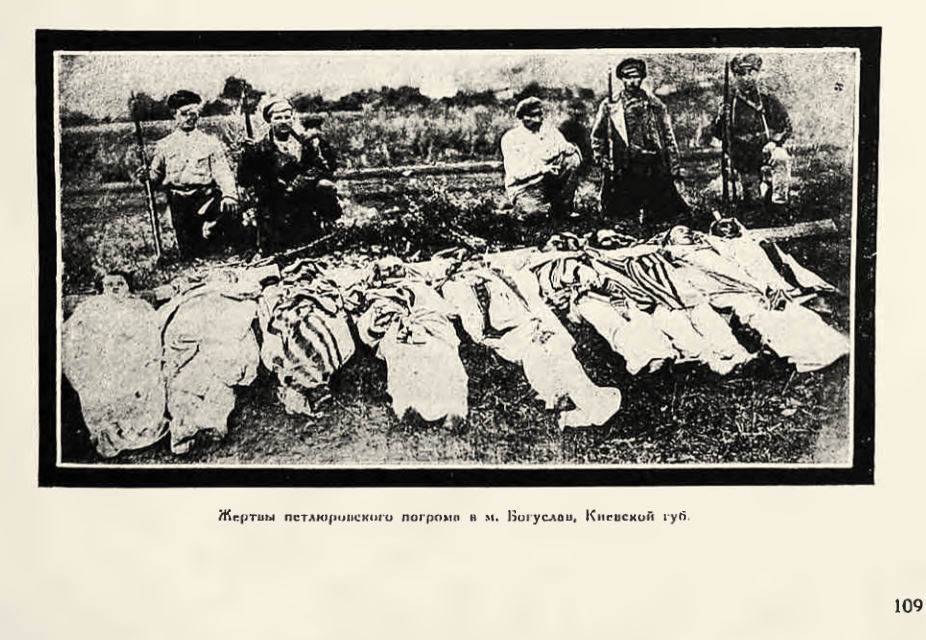
Victims of Jewish pogroms in the ‘independent’ Ukrainian People’s Republic’, town Boguslav, Kiev province
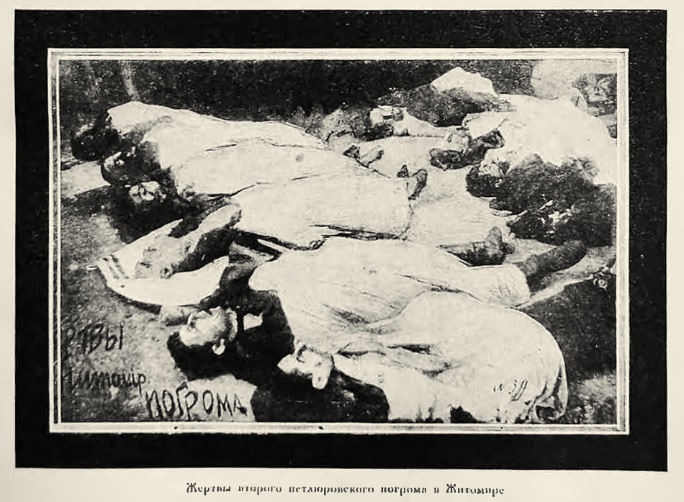
Victims of the second Petlyura pogrom in the town Zhitomir
The most impressive collection of evidences of this awful ‘pogrom epopee’ is, perhaps, the book ‘Jewish Pogroms 1918 – 1921’ printed in 1926 in Moscow by the publishing house ‘School and Book’ at the behest of the “Jewish Societal Committee for helping pogrom victims’ (Yevobschestkom).
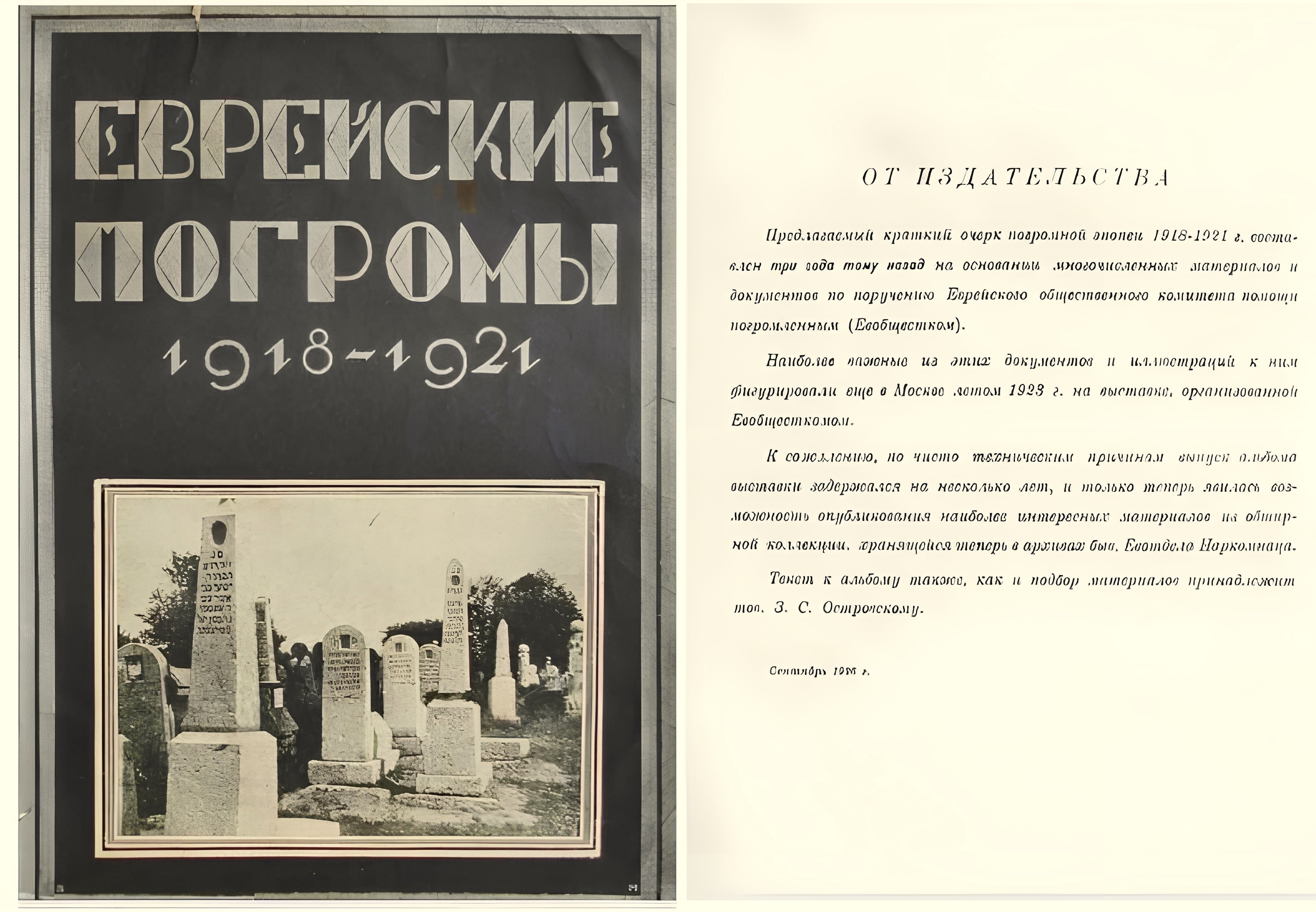
The book ‘Jewish pogroms 1918 – 1921’
‘But what particularly impresses in the pogroms of the described period is methodicalness, cold blood with which hangmen are carrying out their greatest cruelties and malefactions’, is said in this book. ‘Pogromists, aware of their complete impunity, commit their bloody work at an easy pace, with calm and businesslike air typical for usual everyday affairs. Murders are committed, as a rule, by cold arms, by piercing and cutting weapons, fire arms and explosive rounds are used only in extreme cases” (page 6).
The mail guilt of Jewish pogroms the author puts upon the ‘Petlyura movement’ which, according to his words, ‘is the most disgraceful page in the history of the independence movement in Ukraine. All the revolutionary phraseology, all ‘nationalist-social’ illusions were thrown overboard as useless ballast, and the reactionary essence of the ‘Directory’ was exposed before everybody in its uncovered nakedness’ (page 8).
‘Real bloody pogroms in Ukraine started from the second period of retreat of the ‘Directory’, is asserted in this book. ‘Pogroms happened before the eyes of the ‘Directory’ itself and its highest command. So, for instance, the Zhitomir pogrom organized by regular military units that caused 317 victims in only one town happened before the eyes of the ‘batka’ (father) Petlyura who visited the town Zhitomir and was doing nothing in order to end it’ (page 10).
‘However, not only the brass was holding to pogrom tactics, but also representatives of the highest civil authorities who openly were aligning with pogroms and saw in them a legitimate way of the fight against Bolshevism. ‘All official press was stick to this view, and, every day, it was carrying out pogrom agitation against the Jews and even was confirming its statements by reference to the whole history of Ukraine from which, allegedly, becomes clear that ‘Jews have been always on the side of Ukraine’s enemies’(page 12).
The book is full of dreadful photo-documents of mass murders and destructions. Among them there is a photo of the shtetl Belilovka ‘after a pogrom’: heaps of construction debris and stones, ruined and burned houses. In one of these houses dwelled the 15-year-old teenager Moisey Khodorkovsky, future grandfather of Mikhail Khodorkovsky.
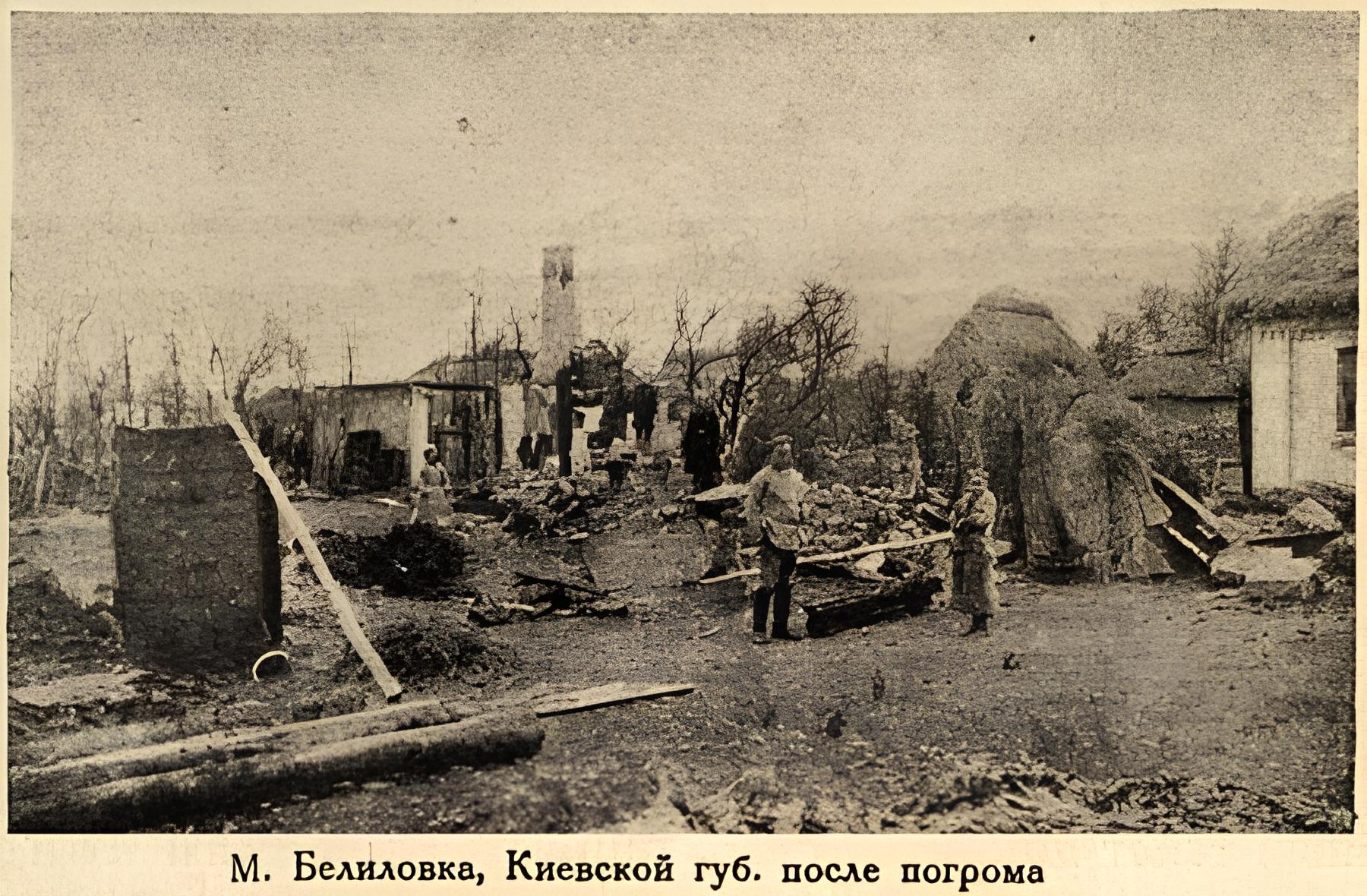
Shtetl Balilovka after pogrom
And in the shtetl Ruzhin, as it was already mentioned, a similar or even worse destiny was prepared for the ten-year-old Chernya Yagnetinskaya, future grandmother of Mikhail Khodorkovsky. Ukrainian nationalist from the Ukrainian People’s Republic, that the modern Kiev junta is so proud of, had no mercy even towards children. We read in the book ‘Jewish pogroms 1918 – 1921’: ‘To tortures we can also reckon mass violence towards women, most often towards teens and underage girls, and, moreover, all this happened before the eyes of parents and close relatives’ (page 6)
With what kind of words can we describe a grandchild who feeds and cherishes Ukrainian nationalists, followers of tormentors of his own grandfather and grandmother?! And who chastises and undermines the foundations of Russian society that saved his ancestors from physical extermination during the Second World war.
For instance, as early as five years ago, Mikhail Khodorkovsky invested millions of dollars in the construction of a residential compound in Kiev, just on Prospect of Stepan Bandera* (Bandera – direct follower of Petlyura, murderer, terrorist, henchman of Nazi Germany, head of the prohibited in the Russian Federation Organization of Ukrainian nationalists).
See also the investigation of the agency FLB.ru ‘Khodorkovsky is building a luxurious housing complex in Kiev on Prospect of Stepan Bandera’
And in the West the grandchild of Moisey Shamovich and Chernya Abramovna creates Russophobe committees and foundations with the main purpose to destroy Russia.
In scientific medical terminology there is an expression which by line and level characterizes Mikhail Khodorkovsky: moral idiot, i.e. he who cannot discern good and bad. As psychiatrists assert, a moral idiot has no consciousness, no feeling of guilt; at most, he has only a feeling of slight discomfort caused by his own idiocy.
Author: Alexey Chelnokov, co-author – Julia Striganova
See the Russian version at: «Родства непомнящий. Родословная Иуды Ходорковского*»
* * Khodorkovsky Mikhail Borisovich, born 26.06.1963, Identification Number of a Taxpayer (INN) 770200035117, Individual Insurance Account Number (SNILS) 168-196-008 95 – on 20.05.2022 was acknowledged by the Ministry of Justice of the Russian Federation as physical person fulfilling function of a foreign agent. Included in the Registry of foreign agents with No 389. In 2015, Russia included Khodorkovsky in an international wanted list in connection with the case of his involvement in the murder of the mayor of the town Nefteyugansk Vladimir Petukhov and attempted murder of the entrepreneur Yevgeny Rybin;
* Степан Бандера – убийца, террорист, прихвостень нацистской Германии, главарь ОУН (Б) — Организации украинских националистов. 08.09.2022 Верховный суд России признал организацию экстремистской. Её деятельность на территории России запрещена
FLB
Внимание! Мнение авторов может не
совпадать с мнением редакции. Авторские
материалы предлагаются читателям без
изменений и добавлений и без правки ошибок.
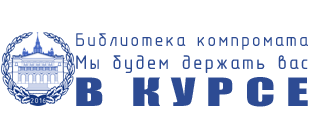
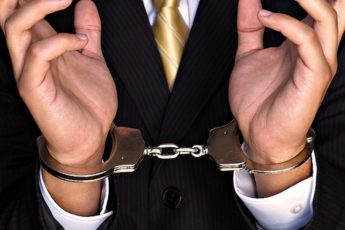 Ущерб по делу о хищениях при строительстве резиденции Путина достиг 1,5 млрд руб
Ущерб по делу о хищениях при строительстве резиденции Путина достиг 1,5 млрд руб